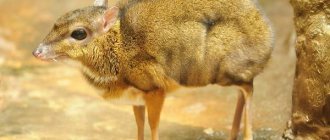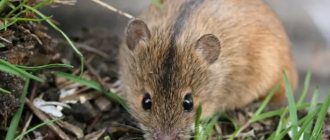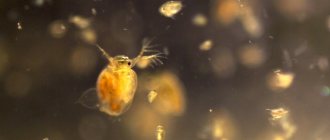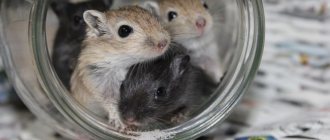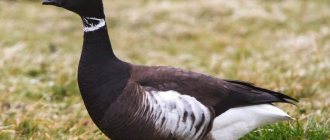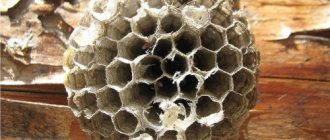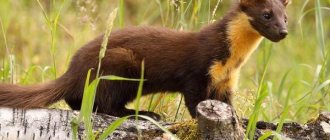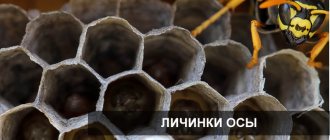Newborns
Rats are born deaf, blind, naked, with a short tail, and undeveloped limbs. Body pink. Seeing such a baby, it is difficult to immediately determine who his mother is and what type of rat she belongs to.
Interesting!
Initially, the weight of a newborn is no more than 6 g. However, body weight increases every day by 2-3 g, since baby rats have an excellent appetite and actively suck the nutritious milk of the female.
On the third day of life, the baby rat appears soft, dark-colored fluff on its back. The future color is already visible. From this moment the next period of the children’s life begins.
What do newborn rat pups look like?
Newborn rats, of course, cause affection and a surge of tenderness, but now all worries about the nursing mother and her children fall on the shoulders of the rodent owner.
The baby rat looks very cute and touching, resembling a pink celluloid baby doll with pink skin and a large round head. Little rat pups are completely hairless and are born blind and deaf, although the sense of smell and instincts in these touching babies are already developed. By smell, the cubs find their mother's nipple, gorge themselves on nutritious milk and fall asleep near the warm belly of the female.
On the large head of a small rat, through the translucent skin, you can see huge dark balls of eyes, which indicates the dark color of the animal. If the contours and color of the baby’s eyes cannot be determined, then the rodent’s fur will be light: red, white or yellow.
A newborn rat pup is very small and defenseless, the weight of the pup at birth is only 3-5 g, the body length of females reaches 5-6 cm, males - up to 9 cm.
IMPORTANT!!! Newborn rat pups should not be touched. The baby’s body is very fragile, one awkward movement can kill the animal. The rat will also not accept a baby with the smell of human hands; excessive curiosity of the owner can result in the death of the baby.
Younger age
Starting from the fourth day, the development of little rat pups occurs at a rapid pace.
- 4th day the ears open, the pups begin to distinguish sounds and hear rustling sounds;
- 6th body is covered with soft dark fluff;
- On the 8th, teeth emerge, except for the main incisors.
After 10 days of life, the pups become active. They crawl well and master the terrain. If these are pets, they should be handled more often so that the animals grow up tame. However, during the game they should not be left unattended, since coordination of movements is not yet developed, the kids can fall to the floor from a table, any height.
The difference between a baby rat and a mouse
How do wild rat pups differ from pups? The main criteria by which baby mice are distinguished:
- small size. Newborn rat pups always mouse more;
- a “dull” muzzle with bulging eyes is another distinctive feature of the mouse;
- thin and very long tail. If in front of you is a baby whose tail is about the same length as itself, then this is a mouse.
- large, round ears.
Rats have:
- a thick tail, which is much shorter than its body;
- small, triangular-shaped ears pressed to the head;
- elongated muzzle with small beady eyes;
- The color of their long and stiff fur is brown or dark gray, while the baby mice are ash-gray, and their fur is short and soft.
The photo clearly shows the difference between the rodents.
The baby rat has an elongated muzzle and a larger body size. Mice have thin and long tails and their size is smaller than a human little finger.
Teen rats
Only on the 14th or even 19th day of life do the pups’ eyes open. At the same time, the body is covered with soft, thick hair. Females develop nipples. By this feature you can distinguish the sex of the animal. From day 20, molars begin to erupt.
During 2 weeks of their life, the pups become active, curious, and boldly leave the nest. They try everything, eat any food typical for adults. They calmly climb ladders and sticks, run and play.
Up to 20 days, the pups become similar in appearance to adult rats. They grow up to 15 cm in length, but have a shorter tail. The baby rat in the photo at this age is shown below.
Little rats
How is it different from a mouse?
Newborn rodents of different species are often confused with each other. The little ones are very similar to each other, but there are still many differences between them. An attentive person will quickly determine by the appearance of the babies exactly whose nest he was lucky enough to discover.
Rat cubs from mice are distinguished according to the following criteria:
- Size. The body of a newborn baby rat will be longer than that of a mouse.
- Muzzle. In a baby rat, it seems to be chopped off and has bulging eyes covered with skin.
- Ears. In the vole they are round and large.
- Tail. Mice have a long and thin tail. It is equal to the length of their body.
The baby rats in the photo will be larger in size. They are slightly thicker and darker than a newborn vole.
Structure and appearance
The tiny mouse is so small that it fits in the palm of a child. The body length of an adult rodent is 60–70 mm, the tail reaches 65 mm. He is a flexible assistant to the baby mouse - he helps her maintain her balance.
It is worth noting the tenacious hind legs, which allow the rodent to perform aerial acrobatic stunts.
The weight of a baby mouse ranges from 7–10 grams.
The fur of this adorable rodent is colored in different colors. The upper part of the body is sandy-ochre, dark orange or white, and the back and tail are yellowish, reddish, brown-red, brown or gray. Unlike other types of mice, this rodent's muzzle is shorter, blunter, and its ears are small.
Distinctive features
Vole mice have their own characteristics that are distinctive from other rodents:
- Depending on their habitat (eastern and western), individuals have different colors and sizes.
- It differs from other rodents by the presence of a smooth stripe along the spine.
- Unlike mice, it has a larger body size.
- It differs from the Dahurian hamster in its longer tail.
- Unlike pieds, it has a longer period of puberty - about 100 days.
- Compared to other subspecies of rodents, the field mouse has an underdeveloped ear.
- Field mice have coarser fur. And adult individuals often develop soft spines, like hedgehogs.
- Field mice belong to the mobile subspecies. They are characterized by seasonal feeding movements.
- May be common in swampy areas. At the same time, they use grass nests as burrows.
Very often, other species of mammals that look similar to voles are mistaken for mice. The most common types of rodents that resemble mice in appearance are:
- . Despite this name, this animal actually belongs to the mouse family, but differs from voles in its larger size.
- . Lives underground and belongs to the hamster family.
And also rodents from the vole family:
- And . They are similar in appearance to mice, but have a number of distinctive features.
- . Forest dwellers, differing from the field ones in the color of their fur coat.
- . This species lives in colonies and is capable of making significant, up to 15 kg, reserves for the winter.
Puberty
Mice reach maturity quite early. In females, the first estrus begins at the age of 30-35 days. The males' readiness to mate is indicated by the descent of the testes into the scrotum. This occurs around the 5th to 7th week of life.
Males can breed all year round. The ability to reproduce in males remains until old age, provided that they are kept in good conditions and receive adequate nutrition.
Despite such early puberty, it is not advisable for a female to give birth to cubs after her first heat. Her body continues to form and is not yet ready for reproduction. Complications may occur during pregnancy or childbirth. For this reason, rodentologists recommend waiting for at least 3 months with the first mating of a female.
Interesting facts about animals
Regardless of size, adult rodents of both species can have a litter of more than 15 or as few as two or three cubs. On average, one litter can contain about 9 cubs.
An interesting fact is that these two types of rodents cannot interbreed. Moreover, they are enemies.
Another curious factor that distinguishes the animals from each other is that the mental abilities of rats are head and shoulders above the abilities of their smaller brothers. Scientists have discovered that they are endowed with abstract thinking, thus putting rats on the same level as us, the only creatures that have this ability.
They will never live where they are in danger; before moving in, they will definitely study the upcoming living conditions. And finally, the rat community lives according to strict laws, strictly observing the hierarchy.
Mice are endowed with intelligence to a much lesser extent. Therefore, the methods of dealing with them are simpler and less sophisticated; for example, glue traps are inexpensive, easy to use and quite effective.
Rats are quite aggressive creatures. Sensing real danger, they are ready to attack even a person. In any case, these animals are not timid. Even if they are not going to attack, they are also in no hurry to run - freezing in place, they cautiously assess the situation and wait.
Their smaller brothers are not so brave; on the contrary, they are very timid. At the slightest rustle they run wherever their eyes look.
Despite the differences, people keep both rats and mice as pets. Domestic, so-called “decorative” rodents are easily tamed, get used to humans, remember their nicknames and even follow simple commands.
Mice never interbreed with rats Mice do not shine with intelligence These pests are very prolific
Not only breeders, but also rodent fighters need to know how mice reproduce and how long they live. Cute domestic animals and terrifying street dwellers, under favorable conditions, are able to reproduce all year round.
Only at sub-zero temperatures does the female stop estrus and the males are not interested in her. An individual gives birth to about 10 cubs at a time, and the next litter may appear 1-2 months after the previous one.
During this period, the babies grow up and are able to become fertilized themselves.
How does mating happen?
Males are ready to breed at any time, but they become especially interested in mating during the female's estrus. At home, mice of different sexes are kept separately. A female is placed with a male only for mating. When rodents live together permanently, the mouse gives birth to one litter after another. This will negatively affect her health.
A female can only give birth to cubs if she meets a male during estrus. During this short period of time, her behavior changes. In the presence of a male, she raises the back of her body and freezes in this position for several seconds.
The acquaintance of opposite-sex individuals does not last long. The male then approaches from behind and performs sexual intercourse. Coitus alone is not enough to conceive babies. It is advisable to leave the couple together for a day to allow several mating attempts to occur. Then the probability of the mouse having babies will increase significantly. In the intervals between mating games, rodents eat, drink water and wash their fur.
Attention! The female should be placed in a separate cage the day after her meeting with the male. She needs rest while bearing her cubs.
In the wild, rodents breed only in the warm season. House mice breed all year round. The animal owner must control this process. Rodentologists recommend mating a female with a male 4-5 times a year. Due to frequent pregnancies and childbirths, immunity decreases and the risk of stillbirth or non-viable babies increases.
Sexual cycle
The sexual cycle in mice lasts on average 5–7 days. This period includes 4 phases:
- precursor (proestrus) - this stage lasts approximately 48–60 hours, during which division of vaginal epithelial cells and keratinization of the upper layer occurs;
- estrus (estrus) – the period lasts 12–18 hours, at this time the upper layer of the epithelium is already keratinized, the female is completely ready for fertilization;
- post-estrus (metaestrus) – the duration of this phase is 24–30 hours;
- Interestrus (diestrus) – lasts about 5 days.
After mating, the female develops an inguinal plug - an additional layer of tissue that protects the mouse from re-fertilization by another male.
There is no estrus during lactation. It resumes 25–30 days after birth, 2–3 days after the female stops feeding the pups.
Attention! When a mouse is ready to breed, it becomes restless and may even show aggression. She takes a characteristic pose, slightly arching her back and raising her butt.
Pregnancy
Pregnancy in mice is indicated by the absence of another estrus. An attentive owner will definitely notice changes in the behavior of the rodent while bearing cubs. Some animals become calmer, others, on the contrary, become irritable or even aggressive.
Until almost the middle of pregnancy, it is impossible to determine that the mouse is carrying cubs in the womb. The rodent looks normal except for the fact that its appetite is slightly increased. The mouse walks smoothly and carefully. Motor activity decreases slightly. In the second half of the term, the abdomen increases in size. Shortly before birth, you can feel the fruit inside.
During pregnancy, mice experience toxicosis:
- the female loses her appetite;
- looks lethargic;
- eyelids drooping;
- drool flows from the mouth;
- sometimes there are cramps.
Important! Toxicosis cannot be treated. A mouse that bears offspring needs to be provided with complete rest, since the main cause of this pathology is stress.
How many babies does a mouse carry?
The gestation period in mice lasts 18-24 days. The duration of gestation depends on how many cubs are in the womb. The greater the number of pups, the faster the birth will begin. The length of gestation can also be affected by the conditions under which the rodent is kept.
In a favorable environment and with good nutrition, the mouse waits 20-22 days for the birth of its cubs.
Caring for a pregnant mouse
From the home of the mouse that carries the cubs, everything unnecessary is removed - the wheel, the tunnels. Access to the second level is limited.
About 10-12 days before giving birth, the mouse begins to build a nest. To do this, she will need pieces of fabric, napkins and paper. The rodent carries all this into the house. If until now the animal did not have a private place in the cage, the owner must equip it. It is there that the mouse gives birth to her pups and takes care of them.
The temperature and humidity in the room should remain approximately the same level. Do not disturb the mouse unnecessarily. Even cleaning the cage during pregnancy is done less often than usual. No noise or contact with other animals is allowed.
Despite the fact that the mouse needs rest, motor activity is not limited. The expectant mother is not prohibited from walking outside the cage, but only under the supervision of the owner.
5-6 days before the birth of the cubs, you need to do a general cleaning of the mouse’s home. All equipment and trays are thoroughly washed and disinfected with boiling water. It is better not to touch the nest if the female has already managed to equip it. If the male was still in the cage with the pregnant mouse, he should be removed.
If this is not done, he can impregnate the female within a few hours after birth.
Feeding
In the first half of the gestation period, the mouse's daily food intake is increased by a third, and in the second half, it is doubled. In addition to the grain mixture, the female should receive vegetables, fruits and fresh herbs. Since calcium and protein are needed for the development of cubs, low-fat cottage cheese, eggs and milk are introduced into the diet.
A glucose solution is added to drinking water. There should be a lick stone in the cage, with the help of which the mouse satisfies the increased need for minerals.
Caring for newborn rat pups
A rat cub is a defenseless, touching creature that requires increased care from its mother and owner. The mother will take care of the feeding and hygiene of the babies; the owner needs to properly care for the female and her offspring, without interfering with physiological processes. To do this, it is advisable to create comfortable conditions for newborn rat pups:
- In no case should you pick up or examine the cubs; the female may abandon or eat the brood from stress;
- the cage with the rat litter should be in the quietest, warmest and driest room;
- The rat cleans the nest on its own, throwing dirty pieces of bedding into the corner of the cage; the owner constantly needs to give the female clean napkins. You can remove used napkins from the cage no earlier than the 8th day of life, without touching the nest. If the rat becomes agitated when cleaning, put it down;
- watch the cage door, the cubs after the 8th day are very nimble and can jump out and crash on the floor, or the female will drag the newborns to any quiet corner of the apartment;
- feed the female with nutritious food and keep the drinking bowl filled with clean drinking water;
- Carefully introduce healthy complementary foods to babies for the proper development of the digestive system of newborns.
Behavior of adults
You can also distinguish mice from rats by their behavior. The mouse is very afraid of people and does not catch their eye, and in case of any threat it tries to run away very quickly. Pasyuki, on the contrary, are very angry and aggressive, and sometimes even attack people. And large individuals sometimes even gather in flocks and fight off enemies together.
Pasyuki do not get along with voles and are not in the same house or outbuildings with them at the same time. If they have already appeared, this means that all other small animals will be destroyed or move to another place.
Keeping white mice: breeding
Pregnancy in house mice lasts on average 22 days (20-26 days) and it proceeds easily and without complications. Typically, in mice, the fetuses in the uterus are located with their heads towards the exit of the uterus and there is no pathology of birth, and cases of death from childbirth among mice are very rare. Childbirth usually occurs at night. One litter usually contains from five to nine mice. It is interesting that just a day after giving birth, the female comes into estrus and is again ready for mating and can become pregnant again. In females, lactation and pregnancy can sometimes occur simultaneously.
Therefore, almost every female house mouse can give birth to up to 10-11 litters in a row. But such intensity of reproduction greatly exhausts it. For this reason, to obtain good offspring, no more than nine litters are allowed.
In normally kept female mice, stillborn pups are quite rare. The reason for this may be a lack of vitamins and microelements in the feed, as well as some infections. But baby mice that were born normal sometimes die soon after birth due to some reason. This may be the lack of milk in the female, an underdeveloped instinct of motherhood, or stress, due to which the female tries to hide the mice, dragging them around the cage, as a result of which they die. Sometimes it happens that pups are born underdeveloped, as they were stunted in growth during the embryonic period, which is most often associated with insufficient and poor-quality nutrition of the female during pregnancy.
Since such pups, as a rule, die, the birth of weak litters serves as a signal of problems associated with the diet or feeding of the animals. But the death of offspring during closely related breeding of mice is almost never observed. Sometimes mice may be born smaller than normal, but, as a rule, they quickly gain the required body weight.
Mice are born naked and with their eyes and ears closed. On average, the weight of newborn mice is about 1-2 g, with a body length of about 3 cm. The mice are born helpless and practically do not move. In newborn mice, determine the sex, i.e. It is almost impossible to distinguish females and males. But at a later age, males become larger than females.
During this period, it is necessary to maintain high milk production of the female. There should always be good quality milk and fresh water in the cage. Newborns grow quickly. Their mass doubles on the fourth or fifth day, and the linear dimensions of the body increase. On the third to fifth day after birth, the baby mice's ears open and their bodies begin to become covered with hair. The first teeth - the lower incisors - erupt on the eighth day, and the upper ones - on the 14th day after birth. At two weeks of age, the mice's eyes open and they begin to see the world around them. The pups emerge from the nest around the third week of life and from that time begin to consume food on their own. The weight of mice at this age averages about 8-8.3 g.
Soon after this, on the 20-25th day after birth, the young animals are weaned from females and mother's milk. At the same time, if the female is lactation and pregnant at the same time at this time, then the young animals should be weaned at least a day or two earlier than the stated period. And immediately during jigging, it is advisable to seat the males and females in different cages to avoid their mating. And after weaning from mother's milk, the pups continue to grow rapidly, reaching 11-12 g by the age of one month, depending on gender, their body length is about 6 cm, and their tail is about 5 cm. And only by six to seven months in whites mice complete their growth and development and stabilization of body weight and linear dimensions occurs. By this time, young house mice already weigh about 25-30 g. In the future, the body weight of adult mice may change depending on the quantitative and qualitative indicators of feeding and also depend on the conditions of keeping the mice.
Home for rodents
The habitats of these two representatives of the animal world are very diverse. Rats are not at all afraid of very hot climates or severe frosts. The homeland of these animals is Eastern China. Thanks to the development of shipping, they settled throughout the planet. These animals are very active at night, but if necessary, they explore new spaces during the day. Most often they live in burrows, which are very similar to labyrinths. There they make their nest, where they hatch and feed their offspring. All holes are made in such a way that they lead to the very center of this nest, which they carefully line with grass, wool and dry leaves. These dwellings are available for winter and summer.
Mice also live in burrows. Throughout the year they replenish their reserves for the winter. These animals are very shy and most often they are nocturnal. Their burrow is also a kind of labyrinth where a whole family lives, but one animal can also live. Despite their small size, in case of danger they will be able to boldly and bravely defend their shelter.
The teeth of these rodents are also different. Rats have only two types: 12 molars, 3 on different sides of the jaw, and 4 incisors.
The molars are very wide and flat, they are located far away in order to grind food well by chewing it. And their incisors grow throughout their lives; they use them to chew through very hard objects. Their teeth are yellow in color and have strong enamel. They have a very interesting feature - they can be moved apart when chewing food.
What do different types of rats look like?
These rodents avoid water whenever possible. But pasyuks are good swimmers and can stay in the water for up to several hours; sometimes, to get food, they dive deep, hunting for various mollusks and even frogs, and are not afraid to be under water for a long time.
Nutritional Features
The marks left on plastic, rubber, wood and other inedible materials give the impression that house mice are omnivores. In nature, the rodent is content with seeds. grain crops, cereals, legumes. Eats seeds of cultivated and wild plants.
A certain part of the diet is occupied by insects, worms, caterpillars, larvae, and carrion. When there is a lack of water, house mice eat the succulent parts of the plant. A rodent needs about 3 ml of liquid per day. If this rule is not followed, the animal dies from dehydration within 15 days. When there is an excess of food, rodents make food reserves for a rainy day. Occasionally they destroy birds' nests and feast on eggs and small chicks.
In a human home, the diet of mice expands significantly. Pests eat all food supplies, any products. And also soap, candles, indoor flowers, glue.
Has its own characteristics. The teeth of rodents have unusual properties. Each jaw has incisors that grow daily throughout life. The animals are forced to constantly grind them down, otherwise they will not be able to close their mouths. For this purpose, they chew hard, inedible materials - wood, plastic, foam plastic, brick, rubber and the like.
Difference between rats and mice
Rats and mice are representatives of the same suborder, but they differ significantly in appearance and behavior.
The body of a mouse is small, up to 20 cm, weighing up to 50 grams, rats are twice as large, they are dense and muscular, weighing up to 900 grams.
Pronounced distinctive shapes of the head and eyes, in mice it is triangular and slightly flattened with large eyes, in rats the muzzle is elongated with small eyes.
A strong body and powerful toes allow rats to jump high up to 1 meter; mice cannot do such tricks.
Mice are cowardly animals and are afraid to appear in front of people, but this does not bother rats; they can defend themselves. There are many cases where they attacked a person.
Rats are omnivores, eating meat and plant foods. On the contrary, mice have a greater preference for cereals and seeds.
Dimensions
Size is the main difference by which these rodents can be distinguished. The average body length of a baby rat is 7–10 cm, the same as an adult mouse. And rats grow up to 25 cm.
The weight of rodents also differs significantly. Rats are larger and therefore heavier than mice. An adult weighs on average 220–250 g. Moreover, males are much larger than females. Their weight with proper nutrition can reach 450 g. An adult mouse weighs only 45–85 g.
Important! In rare cases, rats can grow to gigantic sizes. In nature, there were individuals whose weight exceeded 1 kg. The length of such a rodent can reach 40–50 cm.
Head and ears
Mice differ from rats in the shape of their heads. In rats, the muzzle is strongly extended forward. And in mice it is slightly shorter and has a triangular shape. Rats have much smaller eyes.
Outwardly, they resemble black beads. Mice have large and mobile eyes. Rodents also rotate their heads differently. To do this, rats need to move their torso, and mice can twirl it without the participation of the body.
Mouse
Rats and mice differ from each other in the shape of their ears. In large rodents they are small, triangular and covered with sparse villi. In some subspecies their ends are blunted.
A mouse differs from a rat in having larger, movable ears that it can move. Rats can't do that. Mice have round ears and no hair on them.
Paws and tail
Due to their size, rats move primarily in horizontal places. To find food and escape from predators, they need to run fast and jump high. Therefore, their paws are powerful and muscular, and between the toes there are rough outgrowths of skin visible - these are rudimentary membranes.
Due to their light weight, mice can easily climb vertical surfaces. They are helped in this by small and flexible paws with tenacious claws.
Mouse
Rats have a short tail. It is thick and bristly, there is no hair on it. Its size is approximately half the length of the individual’s body. Mice have a thin tail. Its length is at least ¾ of the body size.
Rat
Wool
Rats have dark gray, dirty-colored fur. The hairs are thick and coarse, and the skin underneath is easily visible.
Important! Decorative individuals have softer wool. Its color depends on the species. Pet stores sell white, red, gray and black rodents. There are also individuals with a hood of a different color.
Decorative rats
The fur of mice is softer and silkier. These rodents have a smoky, grayish color. The hairs grow denser, so the skin is not visible through them.
Mice
How to distinguish an adult mouse from a baby rat
There is often confusion when comparing an adult mouse to a baby rat. Indeed, how to distinguish these mammals from each other when they have so much in common.
As already mentioned, small rat pups have a “blunted” face, small oblong ears and a short, thick, hairless tail. While a mature mouse has a pointed short muzzle with relatively large ears, the length of the tail, which is covered with sparse, barely noticeable hairs, is almost equal to the length of the animal itself.
Baby rats have membranes on their soles that mice don't have. Already at the age of one month, the size of its paws is equal to the size of an adult dog.
But the traces they leave are very different from each other. The fingers on the print of a baby rat are spread wide apart, folds are noticeable between them, while on the mouse, on the contrary, they are pressed tightly together.
Due to the fact that rats move by jumping, their tracks are rare and pronounced, in contrast to the frequent ones of mice, whose owners “mince.”
As you can see, despite a certain similarity between these rodents of the mouse family, they have some differences.
Sometimes an adult mouse is confused with a baby rat. A mouse has a number of features
Differences in behavior
If the pests were not caught red-handed, their presence can be determined by evidence. What is the difference between a mouse and a rat - the most important points.
Traces of a break-in
It is necessary to inspect the sites of sabotage. Rats are carnivores by nature. They prefer meat, lard, smoked meats, and carry bread, sausage, and cookies. They chew hard objects, preferring wood. They easily gnaw electrical wires and cords. They live near food waste and garbage cans.
Mice prefer grains, flour, sugar, cereals, and occasionally eat meat products. They leave behind damaged bags, plastic bags, newspapers, books, and leather goods. You can distinguish by these signs.
Footprints
They can freely talk about a pest that secretly hunts in the dark. The mouse leaves behind a chain of small steps located in close proximity to each other. The animal climbs well on shelves, window sills, cabinets, and rarely jumps. Mouse tracks in the snow are very clearly visible.
The rat moves with confident, long steps. If necessary, it can jump up to 1.5 m in height and up to 2 m in length. By this sign you can recognize the pest.
The footprints in the snow of a rat and a mouse are different: the former have round paw prints, while the rats have long ones.
On a note!
Rats rarely crawl into the house; they prefer outbuildings, cellars, warehouses, barns, sheds, and poultry houses. Don't mind eating chicken or gnawing on a pig's ears. Every farmer dreams of getting rid of rats in a chicken coop or barn. It can drag away a small puppy or kitten. If it enters a house, it usually hides under the floor. Mice love to live in human homes. They live in walls with insulation, under the floor, in the attic. At night you can often hear rustling sounds and the movement of small paws.
How a rat takes care of its pups
Rodents by their nature are excellent mothers; a rat spends the entire day with its pups, tenderly caring for, feeding and caring for the babies. The female covers her large brood with her body all day, warming and protecting the cubs. The warmth of the rat's body and frequent feeding with nutritious milk stimulate the development of all organ systems of small animals; it is almost impossible to feed and keep newborn babies alive without the care of the mother.
Sometimes a rat produces a litter of 15-20 pups
, some of the stronger cubs more often than others end up near the nipple with milk, the rest of the pups may die without feeding. In such cases, in the second week, you can place briefly fed nimble babies in a separate container, maintaining a constant temperature of 39C in it; for this purpose, you can use a heating pad or bottles of warm water.
At birth, baby rats cannot empty their bowels on their own; the mother often licks the babies' bellies, stimulating bowel function and removing newborn feces.
A small rat is a completely hairless creature; the body of a tiny animal becomes overgrown with fur only in the second week of the rodent’s life. Decorative rat cubs are not able to maintain a constant body temperature, so naked babies physically cannot survive without the warm belly of their mother.
If the mother leaves the newborns for a few minutes, the body temperature of the pups instantly drops, they stop moving and fall asleep. The mother carefully monitors the body temperature of each baby all day, and if necessary, the rat changes places between the children.
The rat gradually reduces the time spent near children, adapting newborns to environmental conditions and independently maintaining normal body temperature. If at birth the female practically does not leave a brood, then by the end of the first week the babies spend a third of their time without their mother, with a further increase in their independent period.
Reproduction and lifespan of rats
Rats do not have a mating season; they can breed year-round. But the peak of sexual activity comes in spring and summer. The female mates with different males, pregnancy in rats lasts up to 24 days, and the lactating female carries the cubs for up to 34 days.
Rats prepare nests in advance and cover the bottom with soft grass, cloth, and paper for the birth of offspring. The cubs emerge naked and blind. When dead rat pups are born, the mother devours them; the number at birth can be up to 20.
- The male can eat all the offspring if there are non-viable rat pups; he does not take part in caring for them. The female, on the contrary, provides meticulous care, feeds milk, licks the babies and removes debris from the nest.
After 17 days, the little rats open their eyes, and a month later they lead a full-fledged life on their own. Puberty begins after 3-4 months, and they can reproduce 6 months after birth. Life expectancy is up to two years.
Gray rats breed up to 8 times a year, but black rats breed only in the warm season. Today, experts estimate that there are 2 rats per person in the world.
Childbirth
Most often, mice give birth at night. Mice are born between midnight and 4 am. In rare cases, childbirth occurs in the evening between 16:00 and 20:00. Shortly before the start of labor, the female climbs into a pre-arranged nest. She does not need help, all actions are performed instinctively. The mouse takes the most comfortable position - most often it lies on its side, but it can also sit on the sacrum.
When labor begins and the first mouse appears, the female grabs it with her teeth and pulls it out. Then she gnaws through the membrane of the amniotic sac and gnaws the umbilical cord. After all the mice have appeared, the mouse carefully licks them and then eats the afterbirth.
Typically, if everything goes well, tiny mice are born every 5 minutes. If the delay is more than 15 minutes, then most likely the mouse is stuck, for example, due to its too large size. At home, a person helps a rodent in this situation; in nature, a mouse can die.
Kids
All mice give birth to one mouse at a time, but it is very difficult to say in advance how many there will be. How many pups a mouse gives birth to depends on the species and age of the female, and the number of births. Most often, a litter contains from 5 to 9 babies, but in general their number can vary from 1 to 15.
Newborn mice are naked, blind and deaf, their weight is about 1.5 g, and their size does not exceed 2 cm. Their skin is so thin that their insides can be seen through it.
Why are rats dangerous?
Rats are a disaster for all humanity. They gnaw through walls in the basements of houses, sewer pipes, damage electrical mains, and damage crops.
Rats are carriers of more than 20 infectious diseases, such as leptospirosis, plague, salmonellosis, pseudotuberculosis and others. Many are dangerously fatal to human life.
It is difficult to exterminate rats using chemicals because the animal’s body quickly adapts to the poison and develops protective immunity to toxins.
Where can mice come from in an apartment?
Animals get into the apartment in different ways. Most often through the basement or attic, where they come in search of warmth. Unsealed holes near water and sewer pipes, cracks in baseboards, garbage chutes, etc. become open gates for them.
Interesting materials:
How should you iron neoprene? How should one address the Empress? How should an ammeter be connected to a circuit? How should you remember for 40 days? How should you run correctly? How should seeds be stored correctly? How should stitches be removed? How should you save yourself if you find yourself in a chlorine emission zone? How to protect raspberries so they don't grow? How to open an iPhone if you forgot your password?
Interesting and educational facts about the life of rats
In India there is a Karni Mata temple where rats are revered, cared for and protected. If the rules for caring for a sacred animal and killing it are violated, this person is obliged to bring a golden figurine in the form of a rat to the temple.
In some American states, it is illegal to hit a rat with a baseball bat and can result in a $1,000 fine.
In Asian and African countries, rats are considered a worthy delicacy for a festive dinner. Rat meat is considered a delicacy.
A gray rat eats up to 12 kg of various cereal products per year. Experts have calculated that every year about 6 kg of one farmer’s harvest is spent on feeding one rat.
Sources
- https://notklop.ru/krysy/o-krysah/malenkie-krysyata/
- https://litbro.ru/gryzuny/mysh/mysh-malyutka
- https://litbro.ru/gryzuny/mysh/o-detenyshah-myshey
- https://1klop.com/chem-pohozha-i-otlichaetsya-myish-ot-kryisyi
- https://zelenyjmir.ru/krysa/
- https://litbro.ru/gryzuny/mysh/kak-otlichit-mysh-ot-krysy
- https://notklop.ru/krysy/o-krysah/krysy-i-myshi/
[collapse]
How is it different from an adult mouse?
A rat reaches its maximum size by one year. The appearance of a rat at the age of one month is similar in appearance to an adult mouse. People who do not know the difference between baby rats and adult voles use the wrong control tactics and therefore cannot get rid of pests.
The easiest way to identify a mammal is by the track it leaves on damp ground. A rat's feet are webbed, so a print with widely spaced toes and folds between them will be visible on the ground. Rat tracks in the snow are clearly visible.
The size of a month-old baby rat's paw is no different from the size of an adult mouse's foot.
Animals also move differently. The mouse minces and the rat jumps. If the tracks on the ground are located close to each other, then there was a hole running through here.

